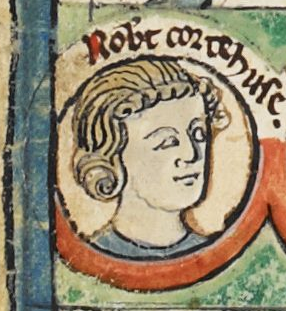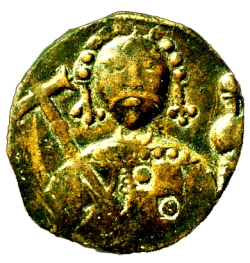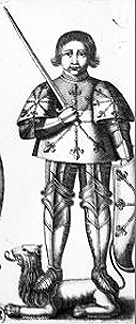
William I, usually known as William the Conqueror and sometimes William the Bastard, was the first Norman king of England, reigning from 1066 until his death in 1087. A descendant of Rollo, he was Duke of Normandy from 1035 onward. By 1060, following a long struggle to establish his throne, his hold on Normandy was secure. In 1066, following the death of Edward the Confessor, William invaded England, leading an army of Normans to victory over the Anglo-Saxon forces of Harold Godwinson at the Battle of Hastings, and suppressed subsequent English revolts in what has become known as the Norman Conquest. The rest of his life was marked by struggles to consolidate his hold over England and his continental lands, and by difficulties with his eldest son, Robert Curthose.

Robert II of Normandy, or Robert Curthose, was the eldest son of William the Conqueror and succeeded his father as Duke of Normandy in 1087, reigning until 1106. Robert was also an unsuccessful claimant to the throne of the Kingdom of England. The epithet "Curthose" had its origins in the Norman French word courtheuse 'short stockings' and was apparently derived from a nickname given to Robert by his father; the chroniclers William of Malmesbury and Orderic Vitalis reported that William the Conqueror had derisively called Robert brevis-ocrea.

Robert "Guiscard" de Hauteville, sometimes Robert "the Guiscard", also nicknamed “Terror Mundi”, was a Norman adventurer remembered for his conquest of southern Italy and Sicily in the 11th century.

Maine is one of the traditional provinces of France. It corresponds to the former County of Maine, whose capital was also the city of Le Mans. The area, now divided into the departments of Sarthe and Mayenne, has about 857,000 inhabitants.
Hugh de Grandmesnil, , is one of the proven companions of William the Conqueror known to have fought at the Battle of Hastings in 1066. Subsequently, he became a great landowner in England.
Roger de Montgomery, also known as Roger the Great, was the first Earl of Shrewsbury, and Earl of Arundel, in Sussex. His father was Roger de Montgomery, seigneur of Montgomery, a member of the House of Montgomery, and was probably a grandnephew of the Duchess Gunnor, wife of Duke Richard I of Normandy, the great-grandfather of William the Conqueror. The elder Roger had large landholdings in central Normandy, chiefly in the valley of the River Dives, which the younger Roger inherited.
Robert de Bellême, seigneur de Bellême, seigneur de Montgomery, viscount of the Hiémois, 3rd Earl of Shrewsbury and Count of Ponthieu, was an Anglo-Norman nobleman, and one of the most prominent figures in the competition for the succession to England and Normandy between the sons of William the Conqueror. He was a member of the powerful House of Bellême.

Odo of Rennes, Count of Penthièvre, was the youngest of the three sons of Duke Geoffrey I of Brittany and Hawise of Normandy, daughter of Richard I of Normandy. Eudon married Agnes of Cornouaille, the daughter of Alan Canhiart, Count of Cornouaille and sister of Hoel II, Duke of Brittany who was married in 1066 to Eudon's niece Hawise, Duchess of Brittany.

Geoffrey II, called Martel, son of Fulk the Black, was Count of Anjou from 1040 to 1060 and Count of Vendôme from 1032 to 1056. He fought battles against William VII, Duke of Aquitaine, Theobald I, Count of Blois, and William, Duke of Normandy. During his twenty-year reign Geoffrey II faced the ambitions of the Bishop of Le Mans, Gervais de Château-du-Loir, but was able to maintain his authority over the County of Maine. Martel founded the Abbey aux Dames in Saintonge and also -in collaboration with his wife Agnes- founded the Abbaye de la Trinité at Vendôme. The first mention of Geoffrey II in the Gesta Normannorum Ducum reads: "Geoffrey, count of the Angevins, nicknamed Martel, a treacherous man in every respect, frequently inflicted assaults and intolerable pressure on his neighbors."
Amaury III de Montfort was a French nobleman, the Seigneur of Montfort-l'Amaury, Épernon, and Houdan in the Île-de-France and Count of Évreux in Normandy.
Robert de Mowbray, a Norman, was Earl of Northumbria from 1086 until 1095. Robert joined the 1088 rebellion against King William II on behalf of Robert Curthose, but was pardoned and later led the army that killed Malcolm III of Scotland at Alnwick. In 1095, he conspired to put Stephen of Aumale on the throne, was besieged by the king, and captured. As punishment, his marriage was dissolved and his lands confiscated, given to the new husband of his former wife, while Mowbray was imprisoned for life and later became a monk.
Herbert I, called Wakedog, was the count of Maine from 1017 until his death. He had a turbulent career with an early victory that may have contributed to his later decline.

Alan Rufus, alternatively Alanus Rufus (Latin), Alan ar Rouz (Breton), Alain le Roux (French) or Alan the Red, 1st Lord of Richmond, was a Breton nobleman, kinsman and companion of William the Conqueror during the Norman Conquest of England. He was the second son of Eozen Penteur by Orguen Kernev. William the Conqueror granted Alan Rufus a significant English fief, later known as the Honour of Richmond, in about 1071.

Elias I, called de la Flèche or de Baugency, was the Count of Maine, succeeding his cousin Hugh V, Count of Maine.
Hugh IV was Count of Maine from 1036 to 1051.
Events from the 1080s in England.

Hubert II de Beaumont-au-Maine, also known as Hubert de Sainte-Suzanne, was a French viscount of Beaumont and Maine, and later of Vendôme. In the 11th century he held the French territories of Beaumont, Fresnay and Sainte-Suzanne.

Hugh III became Count of Maine on his father Hugh II's death, c. 991.
William of Évreux or William d'Évreux was a member of the House of Normandy who played an influential role during the Norman conquest of England, one of the few Norman aristocrats documented to have been with William I at Hastings. He was the count of Évreux in Normandy as well as additional lands and expanded his holdings by consenting to the marriage of his young ward and niece Bertrade to Fulk the Rude of Anjou, whose support against the Manceaux rebels was important for William's liege Robert Curthose. A feud between William's wife Helvise or Heloise of Nevers and Isabel of Conches, the wife of Raoul II of Tosny, led to open war between the two men. Helvise also governed Évreux in William's infirm old age until her own death. Having no children of his own, William was succeeded at Évreux by his sister's son Amaury of Montfort.

The Domesday Book of 1086 AD lists King William the Conqueror's tenants-in-chief in Snotinghscire (Nottinghamshire), following the Norman Conquest of England:











